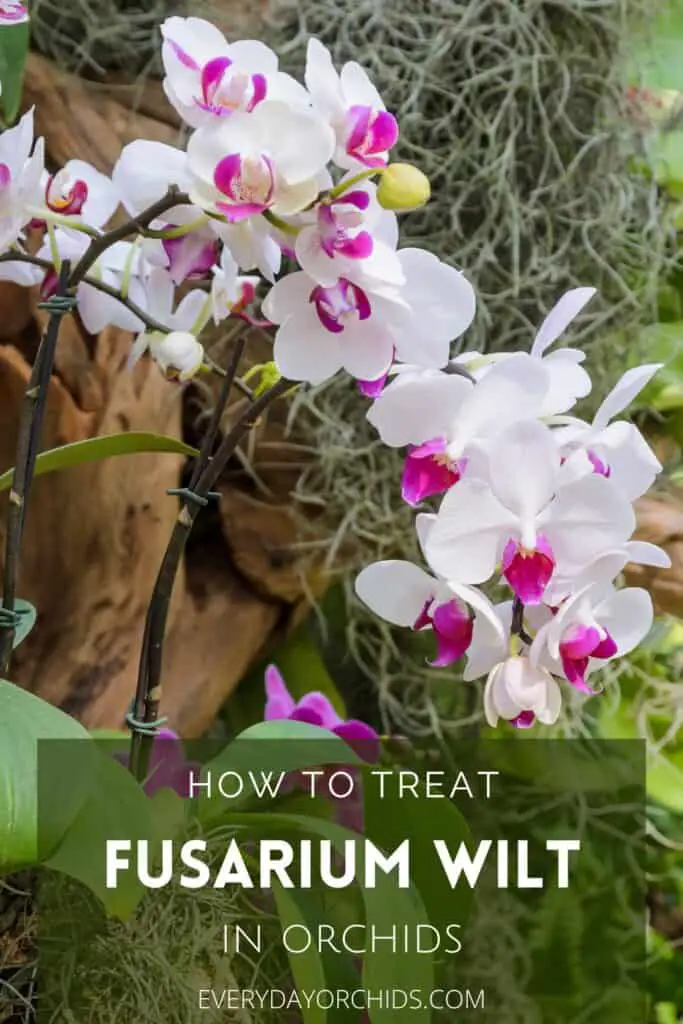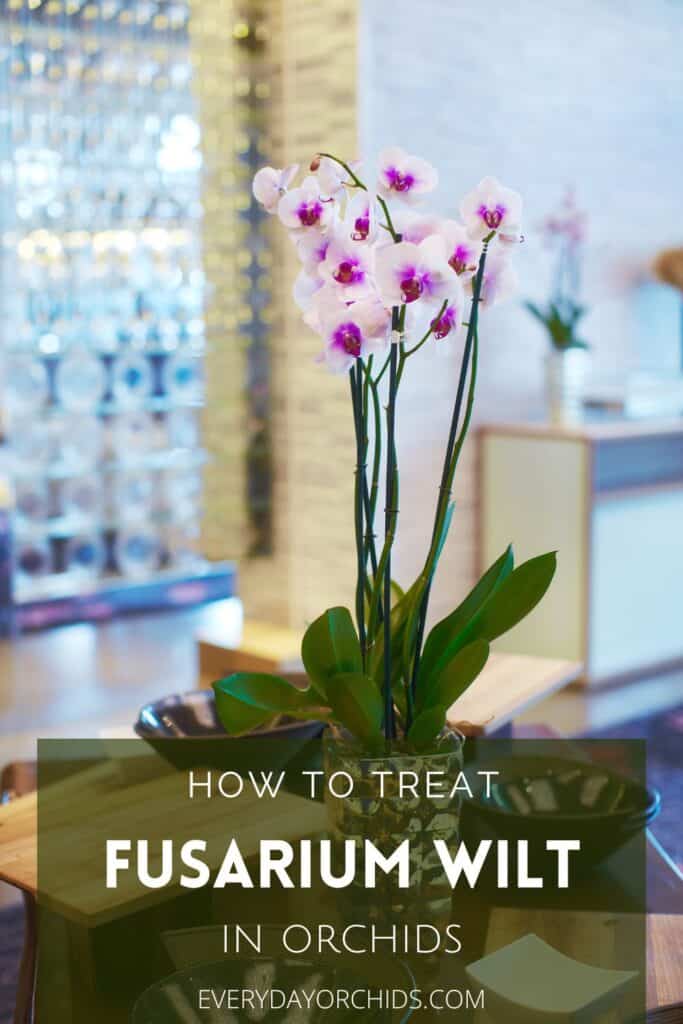Fusarium wilt in orchids is, unfortunately, a problem that you may encounter at one point or another. It is caused by the Fusarium pathogen and this kind of infection can be hard to identify at first.
You might notice that your orchid isn’t looking as lively lately. Maybe the leaves are yellowing, the roots are rotting or the orchid just looks like it starting to die. What’s happening? As you are investigating, ask yourself, could your orchid be infected by Fusarium?
Fusarium is a fungus that affects all plants, including orchids. Fusarium infections in orchids are also called “Fusarium wilt.” Orchids affected by this microorganism may display various signs of distress, such as yellowing or wilted leaves and discolored or rotting roots. Treatment options include pruning off affected areas and treating with a fungicide spray.

In this article, you’ll learn more about how to correctly identify a Fusarium infection AKA Fusarium wilt in orchids. I’ll go over what causes this disease and how it gets transferred from other plants to your orchids. You’ll learn the best ways to treat Fusarium infections in orchids as well as how to prevent it from coming back in the future. Keep reading to learn more.
Please note that these links are affiliate links and as an Amazon Associate, I earn from qualifying purchases. Purchases made through affiliate links in this post may generate commissions at no additional cost to you. Use this link for a discounted Amazon Prime trial. Thank you for your support!
Table of Contents
What Is Fusarium Wilt In Orchids?
Fusarium infections in orchids are caused by the Fusarium oxysporum fungus. This fungus is highly contagious and moves easily from plant to plant. It is one of the main causes of fungal infections and can affect a variety of plants, not just orchids.
Fusarium can enter orchids through diseased or rotted roots. In orchids with pseudobulbs, this fungus can also enter the plant through cuts on the rhizomes when an orchid is divided.

Recognizing Fusarium Wilt In Orchids: Signs And Symptoms
When dealing with Fusarium infections, there are a few telltale signs that will help you quickly identify this pathogen in your orchid.
Changes In Leaf Color And Texture
One common sign of Fusarium infections in orchids is the appearance of yellow or brown streaks on the leaves. As the disease progresses, leaves become fully yellow and start to thin out. As the leaves thin out, they’ll start to become limp and wilt. Hence, the name Fusarium wilt.
In addition, older leaves may become wrinkled and leathery. Newer orchid leaves may develop a reddish or purplish tint. If left untreated, the orchid leaves will start to fall off.
Sunken Spots In The Leaves
In the early stages of Fusarium wilt in orchids, you may also see the leaves start to droop and develop sunken areas along the leaf surface. As the infection spreads, these sunken spots can increase in size. Overtime, they will eventually affect the entire leaf surface.
It is also worth noting that infected leaves may weaken and drop off prematurely. This has the effect of further stressing the plant.
Discolored Rhizomes
If the orchid contracted Fusarium through the rhizomes during orchid division, then you may see a purple or pink discoloration along the infected outer edges of the rhizome. However, you’ll only see this when the rhizome is cut and you are looking at a cross-section of the rhizome.
Changes In Flowering
Another key sign that Fusarium has invaded your orchid is that there will be changes in flowering. Infected orchids may produce fewer flowers or even fail to bloom altogether. Flower spikes may bend easily and drop their flowers or flower buds early. In some cases, the flowers may have deformities or a short lifespan.
By identifying these early signs and symptoms of Fusarium infections in orchids, you’ll be able to take action and provide appropriate treatment for your orchids.

How Do Orchids Get Infected With Fusarium?
Fusarium is a common yet frustrating fungal disease that can affect orchids. It is sometimes referred to as “damping off.”
An infection with Fusarium can lead to various symptoms in orchids, such as dehydration and wilting leaves. In orchids with pseudobulbs, you may also see the pseudobulbs start to shrivel and wrinkle.
Contaminated Pruning Tools
One of the common ways that Fusarium is spread from plant to plant is through improperly cleaned gardening tools. This is because fungal spores, bacteria and viruses can live for extended times on gardening tools.
Sap or residue left on gardening tools will harbor spores, viruses and bacteria. If not properly cleaned, this leftover combination of sap, dirt and microorganisms will be transferred to the next plant during your next pruning session.
Fortunately, there are easy ways to sterilize and disinfect your gardening tools. I’ve reviewed how to clean and sterilize gardening tools on Everyday Orchids and I recommend you check out my guide to cleaning gardening tools. There are a few ways you can go about it, but I usually soak my tools in a diluted bleach solution before and after use.
Damp, Humid Conditions
If the orchid’s potting media remains damp for an extended period of time, this can lead to rot and Fusarium wilt.
Damp potting media can occur due to overwatering, watering too frequently, or high humidity, which causes the potting media to stay wet longer and not dry out. Root rot begins to occur, and as a result, other opportunistic infections, such as Fusarium may appear.
High Temperatures
In addition, heat and hot temperatures are a major factor in Fusarium wilt in orchids.
Orchids are more susceptible to Fusarium infections during the hot summer months. Warm weather and high temperatures can induce stress on plants.
High Humidity
High humidity levels are another contributing factor. Excessive humidity levels, combined with a lack of air flow, provides a conducive environment for the fungus to thrive and infect orchids.
Over-Fertilization
Heavy fertilization can also increase the risk of Fusarium wilt in orchids. Over-fertilizing the plants may weaken their immune system. This makes them more vulnerable to fungal infections like Fusarium wilt.
For some tips, please check out this Everyday Orchids guide on how to fertilize orchids.

How To Treat Fusarium Wilt In Orchids
In order to treat Fusarium wilt, it is essential to follow a few key practices. This includes isolating the infected plant from your other orchids, removing any infected parts of the plant using sterilized tools, and applying remedies such as chemical treatments or homemade solutions.
It’s important to remember that the tools used in the process should be sanitized between cuts. This helps prevent the spread of infection. In the upcoming sections, I’ll explore specific treatment methods and effective prevention strategies to protect your orchids from this dreaded fungal disease.
In my experience, treating Fusarium wilt in orchids requires a combination of careful pruning, proper care, and appropriate use of fungicides. It may even take several treatments before the fungus is eradicated.
Isolate The Affected Orchid
The first thing you want to do if you suspect Fusarium wilt is to isolate your orchid.
Fusarium wilt is highly contagious and can spread easily among plants. It can infect other plant species and spread easily in hot, humid weather. This is especially important if you keep plants in close proximity to each other.
Once you’ve isolated the affected orchid, check all the neighboring plants as well. Look for signs of Fusarium wilt or other disease. If you find any other diseased plants, isolate them too. This is the perfect time to treat all the affected plants together.
Prune Away The Diseased Area
Once you have isolated the infected orchid, gather your supplies. Using a pair of sterilized gardening shears or scissors, carefully trim away any affected tissue. This includes roots and leaves.
If part of the stem, pseudobulb or cane is affected, use a sterilized razor blade for a more precise cut. Cut away and discard any parts of the rhizome that have a purplish or pink discoloration along the outer edges.
To best prevent the spread of disease, re-sterilize your cutting tools after each cut. The fastest and most effective way to do this while you are in the middle of pruning your orchid is to use flame sterilization. This method involves holding the blade over a flame or sterilizing it with a blow torch.
If you are uncomfortable with this, you can use rubbing alcohol instead. Of course, choose one or the other. Don’t use rubbing alcohol around an open flame!
When pruning away rotted or diseased portions of your orchid, be sure to trim away a small part of healthy tissue too. This helps ensure that you get all the diseased plant matter and helps ensure that the infection won’t come back.
In cases where I find a purple stripe on the rhizome or pseudobulb, I remove the infected part and only keep the portion of the plant without purple discoloration.
Use A Fungicide
After you’ve pruned off all the infected plant tissue, you’ll want to follow up with a fungicide. This will ensure that the Fusarium wilt won’t return. The fungicide will kill off any fungal spores that you may have missed during the pruning process.
One good fungicide option is Fung-onil spray by Bonide. This is the anti-fungal spray I use for my orchids and other plants. It contains an active ingredient called Chlorothalonil, which is a broad-spectrum fungicide.
This product from Bonide comes in a ready-to-use spray bottle, no dilution or mixing necessary. It is great for spot applications and smaller plants like orchids.
To use the fungicide spray on your orchids, simply spray it on the affected areas and let it dry. Be sure you spray in the mornings and out of direct sunlight. Do not water your plant on the same day. Observe your orchid for a week or two and look for any signs of disease recurrence. You may need more than one application over several weeks.
In addition, while you are treating your orchids for Fusarium wilt, it’s important to keep the plant drier than usual. This is because excessive moisture can encourage the growth and/or return of the fungus that causes Fusarium wilt.
If you decide to use another brand of fungicide spray, that is fine. Just make sure it has the active ingredient Chlorothalonil.
Home Remedy Options For Treating Fusarium Wilt In Orchids
In addition to chemical treatments, I’ve found success in using some home remedies for treating Fusarium wilt in orchids.
One of my favorite home remedy options for orchids is ground cinnamon powder. This spice is relatively inexpensive and easy to find.
Ground cinnamon has anti-fungal properties as well as drying effects. I use it whenever I am treating rot on my orchids. This is true whether I’m dealing with root rot, crown rot or stem rot. Ground cinnamon powder will also work on Fusarium wilt.
How To Use Cinnamon Powder To Treat Fusarium Wilt
To use ground cinnamon powder to treat Fusarium wilt, simply dab a small amount of ground cinnamon powder onto the cut area of the orchid. This is, of course, after you have already pruned away all the diseased tissue.
Due to the drying effects of the cinnamon, this open area will dry out and “scab.” The anti-fungal properties of ground cinnamon will also help prevent the fungal infection from recurring in that area.
To learn more, read my article about the amazing effects of ground cinnamon in orchids.
If All Else Fails, Throw Away The Plant
I hate to throw away orchids, but in cases of severe Fusarium wilt, this may be your best option. If the infection is wide-spread and very extensive, then it may be too late to save your orchid.
Severely infected plants should be discarded by placing it in a sealed plastic bag in the trash can. Do not simply toss it in the compost pile because the spores may be picked up by the wind and spread around your garden.
What Happens If You Don’t Treat Fusarium Wilt In Orchids
So maybe this all sounds like a lot of work and you are just tempted to see if the infection resolves on its own. Well, I hate to break it to you, but it won’t. If you don’t treat Fusarium wilt in your orchids, the consequences can be devastating. I’ve seen it firsthand. Trust me when I say, this fungal disease can eventually kill your plants.
The initial symptoms of Fusarium wilt may not seem severe. You might notice discoloration along the leaves and stems or wilting in certain areas. However, as the fungus spreads, the plant’s vascular system becomes blocked, leading to severe wilting and the eventual death of the entire orchid.
Without treatment, the fungal spores can also spread to neighboring plants and contaminate your garden, putting other orchids at risk. This is especially concerning in more extensive garden settings or where you’re growing multiple orchids in proximity.
Moreover, Fusarium spores can persist in the soil even after the plant dies. If you don’t address the issue and remove the infected material, the fungus remains in your growing environment. This leads to future problems for any new orchids or plants you introduce into your collection.
Neglecting to treat Fusarium wilt in orchids can lead to the weakening and eventual death of your plants. You also risk spreading the disease to other plants and contaminating your growing environment.

How To Prevent Fusarium Wilt In Orchids
The best thing you can do for your orchids is to maintain a healthy growing environment in the first place. This will help prevent Fusarium wilt or other diseases from affecting your orchids and will save you the hassle of treating the problem and trying to rescue your plants.
Some of the key ways you can prevent Fusarium wilt from affecting your orchids includes avoiding over-watering, maintaining proper temperature and humidity levels, and avoiding over-crowding of plants.
I’ll go over each point in more detail next.
Sterilize Your Pruning Tools
First, sterilize your pruning tools. If your gardening tools haven’t been thoroughly sterilized after each use, you should definitely start doing that. Sterilize your pruning tools before and after use. This is because fungal infections can easily spread from plant to plant via contaminated tools.
Routinely Inspect Plants
Routinely inspect your plants for signs of illness or disease as well. Early detection and treatment will go a long way in saving your orchid and giving it the best chance of recovery. I usually inspect my orchids once a week when I water my orchids.
Avoid Over-Watering Your Orchid
Over-watering is a major cause of root rot and other fungal infections in orchids such as Fusarium wilt.
A good rule of thumb is to use your finger to check the top two inches of potting media to see if it is dry, nearly dry, or still damp. If the potting media is dry or nearly dry, then you can go ahead and water your orchid. If it is still damp, then don’t water your orchid. Wait a few more days, check again and decide from there.
If you are new to orchid care, check out this comprehensive guide to watering orchids in bark, as well as this guide to watering orchids grown in sphagnum moss. I go into more detail in these articles about how you can best water your orchids to keep them healthy and prevent rot.
Ensure Good Air Circulation Around Your Orchid
Along the same lines, make sure your orchid pot has adequate drainage so that the potting media can dry out between waterings.
I like to use these orchid pots with holes to allow for better drainage and air circulation. Since they are lightweight and orchids can be very top-heavy, I generally double-pot these orchids into a heavy outer ceramic pot so they don’t tip over.
In addition, make sure you have good air circulation around your orchids. This means not placing your orchid pots too close together. The leaves of different orchids shouldn’t touch each other. Maintain enough space between the different pots for air to flow through.
You can also use a circulating fan in the room to promote air circulation around your plants. Just make sure you don’t point the fan directly at the orchids. Doing so will stress the plants and leave them more susceptible to illness.
If you don’t have a fan, you can simply open a nearby window. Just try to avoid opening the window right next to the orchids, as they don’t like drafty areas.
Simply having a window in the room open, even if it’s farther from the orchids, will help move air around the room. This will help prevent stagnant air and highly humid conditions from developing around your plants.
Maintain Proper Temperature and Humidity Levels
Temperature and humidity also play a significant role in the prevention of diseases in orchids. The care needs of different orchid species will vary, so be sure you look up your particular orchid’s temperature and humidity needs.
Most Phalaenopsis orchids do best with a 50% humidity level and temperatures between 60 to 85 degrees Fahrenheit. I keep an eye on the humidity and temperature levels around my Phalaenopsis’ growing area using a hygrometer. I’ve used this hygrometer by ThermoPro for many years and would definitely recommend it in a heartbeat.
Don’t Over-Fertilize Your Orchid
In terms of nutrients and irrigation, I also use a balanced orchid fertilizer and fertilize my orchids “weakly, weekly” during the growing season. You can read more about how to fertilize orchids here.
Over-fertilizing your orchid can happen if you fertilize too often or don’t dilute the fertilizer enough before use. This can lead to a weakened root system. It makes orchids more susceptible to disease.
Final Thoughts
Let’s review. The primary cause of Fusarium infections in orchids is the fungus Fusarium oxysporum. Fusarium wilt in orchids is exacerbated by factors such as heat stress, high humidity, and heavy fertilization. By being aware of these risk factors, you can better care for your orchids and prevent Fusarium wilt in your plants.
If your orchid does end up with Fusarium wilt, try combining a proactive approach to orchid care with proper disease identification and prompt treatment. You can successfully treat Fusarium Wilt in your orchids using the treatment steps outlined in this article.
Hopefully this guide has helped you and given you some tips on keeping your orchids healthy and disease-free. Happy orchid growing!
If you enjoyed this article, please pin it and share!





